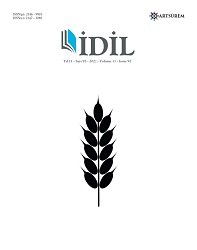ISAAC ALBENİZ’İN ASTURİAS BAŞLIKLI SOLO PİYANO ESERİNİN GİTAR TRANSKRİPSİYONLARINDA DÖNEMSEL VE STİLİSTLİK FARKLILIKLAR
PERIODIC AND STYLISTIC DIFFERENCES IN THE GUITAR TRANSCRIPTIONS OF ISAAC ALBENIZ'S SOLO PIANO PIECE, “ASTURIAS”
Author(s): Kerim Altinörs, C. Bülent ErgüdenSubject(s): Music
Published by: Sanat ve Dil Araştırmaları Enstitüsü
Keywords: Asturias; Isaac Albeniz; guitar transcription; romantic performance; modern performance;
Summary/Abstract: The present study aims to conduct a comparative examination of the Romantic and Modern guitarists’ transcriptions of Isaac Albeniz’s Asturias, a solo piece that was originally composed for piano but that has come to hold a significant place in the classical guitar repertoire. This piece, also known as Leyenda and Prelude, is one of the most transcribed and played pieces in the classical guitar repertoire. Although the most well-known and played Asturias transcription belongs to Andres Segovia, one of the representatives of the Romantic Tarrega school, the first transcription was made by the guitarist-composer Severino Garcia Fortea. In this study, the transcription traditions of the 19th century and the different perspectives that have been seen to date are examined in terms of period and style. After the Romantic Tarrega performance interpretation on the guitar, which broke with Julian Bream and John Williams in their "Historically Informed Performance" approach, many transcriptions involving different interpretations were made in the period marked by the emerging prominence of the modern performance approach. Contrary to the composer-guitarist characteristics and the subjective interpretation of guitarists who adopted the romantic understanding, the modern approach focuses on a more faithful adherence to the composer and style and on different approaches to technique and fingering notation understanding. The transcriptions in the study were assessed on the basis of these features using the comparative analysis method. In the analyses, the original piano notation was also taken into account, and notational changes in transcriptions, dynamics, metric value differences, articulations, and different techniques applied were used as criteria. The transcriptions of Severino Garcia Fortea and Andres Segovia from the Romantic period, and David Russell, Margarita Escarpa, and Manuel Barrueco from the Modern period were selected as the examples. It is anticipated that the results of this study will provide new perspectives on interpretations and transcriptions of Asturias for guitarists.
Journal: İdil Sanat ve Dil Dergisi
- Issue Year: 11/2022
- Issue No: 92
- Page Range: 511-531
- Page Count: 21
- Language: Turkish

